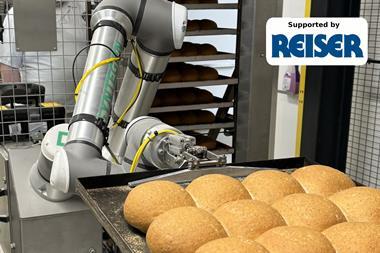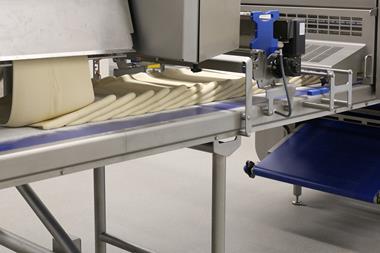Already well established in large-scale businesses, labour concerns means automation is increasingly likely to be seen in bakeries of all sizes
Greggs sausage roll and doughnut production taken over by robots’, screamed the national media last month after the firm reported on its use of automation to increase efficiency.
The move resulted in job losses, and it is concern about labour – specifically shortages of foreign workers in the wake of the Brexit vote – that is helping to drive automation and robotics in the bakery and food-to-go industries.
While automation is well-established in larger bakeries, where soaring capacity has made manual labour impractical, the wider market is now looking at the possibilities.
“Brexit has made businesses accept that their traditional EU source of labour might not exist in two or three years,” states David Jahn, director at robotic packing and palletising systems supplier Brillopak. “Staff will either leave the UK because there are better financial prospects overseas or because of a (real or not) fear of rising xenophobia or immigration issues.”
Ann Wells, group marketing director at Brook Food Group, says bakers are looking to introduce automation to help with the battle of finding good labour. But she warns it is important that the quality or character of production doesn’t suffer as a result.
“With such a strong artisan movement within our industry, the large producers have to maintain the authentic qualities customers require, so it’s crucial any automation introduced still allows this.”
The laborious work of loading and unloading steam tube deck ovens, which enable bakers to produce oven-bottom loaves such as sourdough, ciabatta and focaccia on a large scale, is one area where automation can be employed without impacting the authenticity of the product, Wells suggests. The bread is made in the normal way, then placed on loading trollies, proved and the trolley positioned at the loading station. The process is then fully automatic until the cooling trolley of baked bread is removed at the unloading station.
“This aids increased production and removes the need for skilled labour in the setting of the loaves,” says Wells. “We see this as an example of the industrial sector changing to produce the same products, of the same quality, using automation rather than skilled labour – with less labour required and more consistency across a more streamlined process.”
Installing a mid-size pastry laminator in a bakery previously manufacturing on reversible sheeters could reduce labour by as much as 70% a shift, suggests Rondo general manager Richard Tearle.
And Brillopak claims as much as 90% of a packing line could be automated, stating: “A typical bakery flow wrap packing line may include up to six people feeding a flow wrapper, three packing the products and one person palletising the packs. If there are 10 packing lines and two shifts, this equates to 200 people. Many businesses have traditionally accepted the labour overhead as a fact,” says Brillopak’s Jahn.
Flow-wrap business Ilapak UK agrees the packing line offers opportunities for automation. “A lot of bakeries have been running flow wrappers for years, but use staff to manually load them,” says Ilapak UK sales and marketing director Tony McDonald. “They might have a belt with a high volume of products along it and four or five people on each flow wrapper picking up the products and feeding the machine. We’ve introduced robots to stack products and organise them in batches of two, three or four, then use our multi-belt system to feed them into the machine.”
While automation in the baking industry is often in larger-scale businesses, it also has a role to player in smaller operations.
Oven-loading systems are available for artisan bakers and can be installed on smaller ovens to aid production and save time, explains Wells at Brook Food.
“Options start with the simple manual setter which is the first step up from using trays,” she says. “The next option would be an automatic setter, used alongside a scissor-style lifting device or an integrated loading device built in to the oven’s fascia.
Wells adds that artisan bakeries find that setters and loaders can increase productivity and save time between bakes while reducing manual handling of dough and causing unnecessary stress on the final product.
Jahn says an SME, like any business, will reach a tipping point where automation can help improve productivity, adding that manual labour saving isn’t the only measure. “Automation can reduce manufacturing costs, enable bakeries to run smaller batches of product to reduce stock holding, and ensure consistency of quality and reduced product waste,” he says. “Bakeries can increase and decrease output at short notice in line with demand fluctuations by running extended or weekend shifts at limited additional cost compared to increasing the workforce.”
Rondo supplies several products designed to help small and medium-sized bakeries automate, including its Smartline, which can handle highly hydrated bread doughs, laminated pastry and short doughs.
“There are more than 50 of these lines installed in bakeries in the UK and Ireland,” says Rondo general manager Richard Tearle. He adds that a business spending out on automation could expect a return on investment (ROI) in less than two years.
Brillopak’s Jahn says: “Given the average annual wage of a packer is £8.09 an hour, with the minimum wage rise to £9 by 2020 adding a minimum 16% to the average packhouse wage bill, plus management costs and sickness/holiday cover issues, ROI can be from six months to three years through labour savings alone.
The pros and cons of robots
Robots can take on many repetitive and strenuous tasks that cause musculoskeletal injury, from the manual handling of heavy ingredient sacks to work-related upper limb disorders caused by people performing repetitive tasks such as tin loading, cake decoration and packing.
This was something supplier OAL recently demonstrated at the Anuga FoodTec show, with robots handling, weighing and preparing raw ingredients from 25kg sacks. The firm showed how a collaborative robot can quickly weigh out free-flowing and non-free-flowing powders, to a recipe, with an accuracy of 1g and zero cross-contamination.
“Weighing out powders is a common task across the industry that presents accuracy and health and safety challenges when undertaken by people,” says Jake Norman, head of innovation at OAL.
Robotics firm Motoman Yaskawa says while industrial robots may not be suitable for small and medium-sized businesses, a collaborative robot, or cobot, may be. A cobot is relatively lightweight and is designed to operate safely in close proximity to people. This can eliminate the need for safety curtains or fencing, thanks to the use of proximity sensors or force-limiting technology
Collaborative robots can also provide benefits in terms of safety, cost, quality and ROI,” says Motoman Yaskawa UK sales and marketing manager Jonny Grey.
Last year, Rondo launched the Rondobot rounding system (pictured below) for bread and rolls, which comprises an industrial robot, specialised tool sets and a purpose-built moulding table. It says the system can be integrated into existing, or new, bread and roll lines, and can produce round moulded rolls and bread from 40g to 1000g. The Rondobot can emulate manual rounding “perfectly”, with 100% repeat-ability, says Rondo, and can reach up to 18,000 pieces an hour when producing 60g rolls.
“The applied-for-patent Rondobot represents a bakery technology milestone and forms the basis for extensive application possibilities in the baking industry,” says the business.
Ilapak notes that the more variable a bakery’s product range, the less likely robotics are able to automate the process. “For example, with crumpets, you can put them in a stream, line them up and pick them up three at a time, but if you’ve got a variable system with several different types of product coming down the line at once, it’s much more difficult.
“We integrate robots at both ends of our flow wrap machines. Once the product has been through the flow wrapper, it has already been accumulated and a robot with a vacuum gripper can pick up the pack and put it into the tray.”
When is automation a challenge?
Food industry robotics and automation develop at a rapid pace – but there are still some situations where automating is a challenge.
Automated systems like consistency, and a process where a product or ingredient is variable can cause problems, according to Brillopak director David Jahn.
“Additionally, in terms of end-of-line automation, the number of different layer patterns can dictate viability,” he says. “An example is accurate placement of soft flexible multi packs – for example, packs of partially baked bread rolls, into tight boxes in a combination of vertical and horizontal formats.”
Similarly, producing a wide range of products and formats on the same line puts demands on equipment suppliers.
“The extensive range of bakery products being developed to meet consumer demands for convenience, single portions, family pack sizes etc, could mean a greater number of SKUs to accommodate, with bakery lines having multiple product changeovers in a shift, each involving different products types, packaging materials and packing methods,” says Jahn.
“With the trend towards shorter production runs, in the future bakery packaging machinery will need to be able to switch frequently between numerous different products.”
Gluten-free doughs present considerable challenges to automated systems, says Rondo general manager Richard Tearle, although these are gradually being overcome by working with producers and their recipes.
Wet areas can also be a problem as equipment needs to withstand the harsh washdown procedures required to ensure the area is fully sanitised.
“It’s not impossible but it is very difficult to get completely waterproof robots and flow wrappers to handle harsh washdowns,” says Ilapak UK sales and marketing director Tony McDonald, adding that some of his business’ systems are now fully washdown-compliant.
CASE STUDY: McVitie’s site introduces automated palletising
McVitie’s is using a multi-line robotic palletising system that has paid for itself within 15 months through reduced labour costs, according to supplier Brillopak.
Pladis had called for automated palletising for its distribution hub at Ashby-de-la-Zouch, which was manually palletising boxes of McVitie’s products on seven different lines – a labour-intensive process that was causing congestion in the packing area.
Automating the process was a major challenge, says Brillopak, as the lines are packing more than 60 SKUs into different box sizes, with several product changeovers every day. Brillopak’s solution comprises four compact C2 KT400 single cell palletisers for manual pack stations, a further two KT400 palletisers for each flow wrapper and a KT800 dual cell palletiser for the high-speed cartoner. Its engineers modified the KT400 palletiser to minimise its footprint and weight, optimised the Omron motion control and engineered a new servo-driven robot head with adjustable torque to handle varying case dimensions without the need for a tool changeover.
Brillopak says the robotic solution has transformed “a labour-intensive bottleneck into a seamless and efficient 10-case-per-minute palletising operation”.
“The solution met our needs in terms of layout, performance and price. The small footprint of the palletiser and the flexibility to handle our 50-plus SKUs with no tooling changeover also had a big impact on our decision,” says Pladis logistics project manager Mike Hellier.


























No comments yet